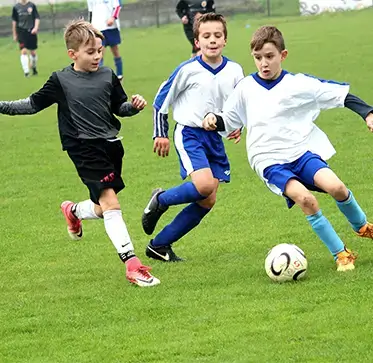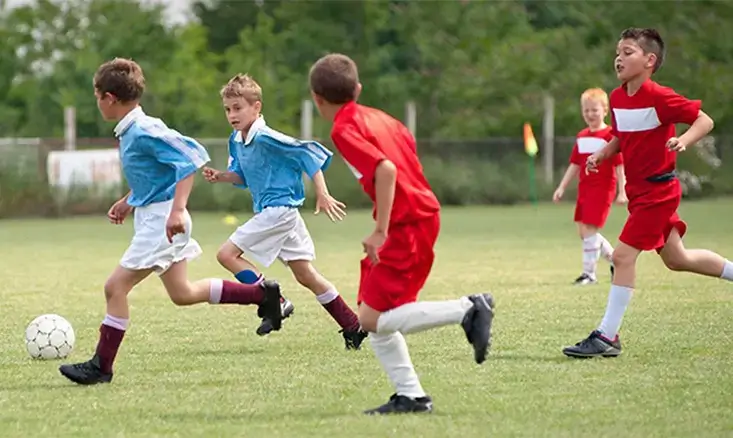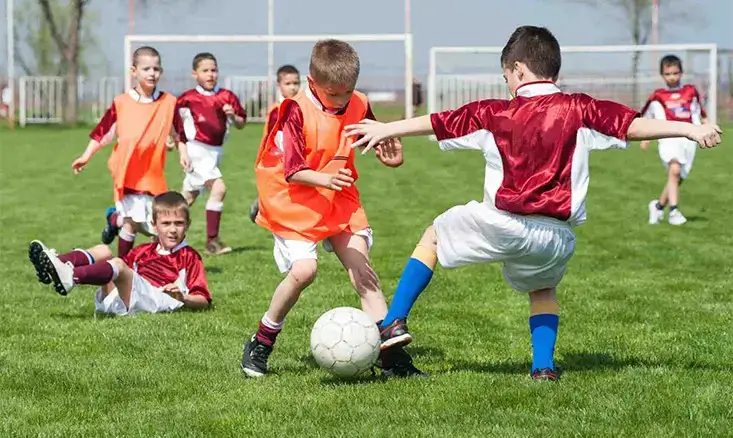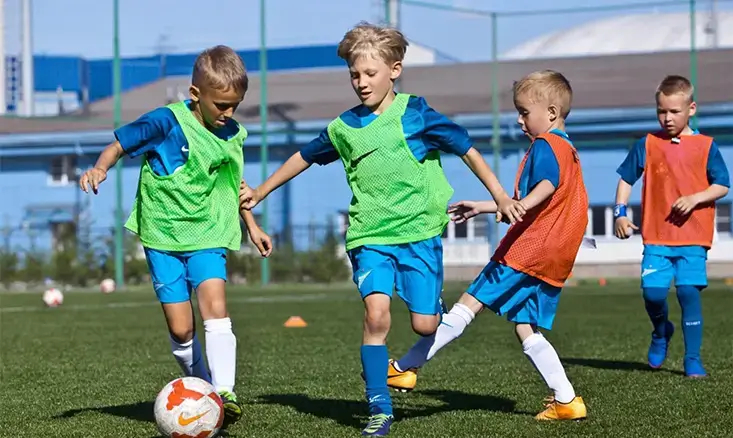The 4-3-2-1 Soccer Formation

CRFC BLOGS
LATEST BLOGS & NEWSLETTERS
The 4-3-2-1 Soccer Formation
The 4-3-2-1 formation is a famous soccer setup that emphasizes a solid defense, a cohesive midfield, and a flexible attack. Due to its structural similarities, this formation is frequently compared to the 4-2-3-1 formation and has unique strengths and weaknesses. Understanding the intricacies of the 4-3-2-1 formation can benefit youth soccer teams and professional levels. This guide will provide a detailed look at the formation, its strengths and weaknesses, player roles, and training drills to help coaches and players make the most of this tactical setup.
Structure and Setup
Defensive Line (4)
The defensive line in the 4-3-2-1 formation consists of four players:
Center-Backs
These two players are the backbone of the defense. They are responsible for stopping the opposition’s forwards and clearing the ball from dangerous areas. They must be strong, good in the air, and excellent at reading the game to intercept passes and tackles.
Full-Backs
Positioned on the flanks, full-backs support the center-backs in defense and advance the field to aid in attacks. They must be quick, make overlapping runs, and deliver accurate crosses into the box. Full-backs also play a crucial role in transitioning from defense to attack.
Midfield Line (3)
The midfield line in the 4-3-2-1 formation is composed of three central midfielders:
Central Midfielders
These players are essential for both defense and attack. They help protect the defense by intercepting passes, tackling opponents, and maintaining possession. They are also responsible for distributing the ball effectively to start offensive plays. These midfielders must be versatile, defend robustly, and contribute to the team’s attacking efforts.
Advanced Midfield Line (2)
Ahead of the central midfielders are two advanced midfielders:
Advanced Midfielders
These players operate in the spaces between the opposition’s defense and midfield, known as half-spaces. They support the lone striker, create goal-scoring opportunities, and contribute defensively by pressing the opposition. These players must be creative, with good vision and passing skills, to unlock defenses and set goals.
Forward Line (1)
At the top of the formation is the central striker:
Central Striker
This player is the main goal-scoring threat. The striker holds up play to allow teammates to join the attack, finishes off moves, and links up with the advanced midfielders to create chances. The central striker must be strong, have reasonable ball control, and have finishing abilities to maximize scoring opportunities.

Key Strengths
Defensive Solidity
Compact Defensive Structure
With four defenders and three central midfielders, the 4-3-2-1 formation provides a solid defensive base that is hard for opponents to break down. The three central midfielders add an extra layer of protection in front of the defense, making it difficult for the opposition to find spaces.
Midfield Contribution to Defense
The central midfielders play a vital role in protecting the defense by intercepting passes and making tackles. They are the first line of defense, pressing opponents and breaking up plays before they can reach the back line.
Midfield Control
Managing the Game’s Tempo
Central midfielders control the game’s pace by maintaining possession and dictating play. They decide when to slow down the game to conserve energy or speed it up to catch the opposition off guard.
Effective Pressing and Ball Recovery
The formation allows for effective pressing, making it difficult for the opposition to build attacks. The advanced and central midfielders work together to press high up the field, forcing turnovers and quickly transitioning to attack.
Attacking Flexibility
Support from Advanced Midfielders
The advanced midfielders link the midfield and the lone striker, creating a dynamic and flexible attacking unit. They can make late runs into the box, play one-twos with the striker, and take on defenders to create scoring opportunities.
Quick Transitions from Defense to Attack
The compact midfield setup allows quick and effective transitions from defense to attack. When the team wins the ball, the central midfielders can quickly pass it to the advanced midfielders or the striker, launching fast counter-attacks.

Key Weaknesses
Vulnerability to Wide Attacks
Lack of Natural Wingers: With wingers, the formation can be protected from teams that effectively use the width of the field to create chances. Opponents with fast and skillful wide players can exploit the space behind the full-backs and stretch the defense.
Dependence on Full-Backs: Full-backs in this formation have many responsibilities. They need to defend against wide players and support the attack, which can leave gaps if caught out of position.
Player Isolation
Challenges for the Lone Forward: The single striker can become isolated if the team struggles to maintain possession or the advanced midfielders must support effectively. The striker needs to be adept at holding up the ball and bringing others into play, but if isolated, they may need help to influence the game.
Support from Midfield: If the central and advanced midfielders are too focused on defense, the striker may need more support, making it difficult to create scoring opportunities.
High Demands on Players
Tactical Discipline: To maintain the formation’s structure, players, especially midfielders, must be highly disciplined. They must understand their roles and responsibilities and be able to read the game well to make the right decisions.
Physical Fitness Requirements: The formation requires players to cover much ground, demanding high fitness levels. Central and advanced midfielders, in particular, must be able to run box-to-box, support defense and attack, and recover quickly.
Comparison with 4-2-3-1 Formation
Similarities
Use of Back Four: Both formations employ a back four, providing a solid defensive base that is difficult for opponents to penetrate.
Crucial Roles of Central Midfielders: In both formations, central midfielders are essential for maintaining possession and supporting defense and attack. They dictate the game’s tempo and are involved in almost every phase of play.
Differences
Width and Wingers in 4-2-3-1: The 4-2-3-1 formation includes wingers, offering more width and making it less vulnerable to broad attacks. This setup allows for more direct and expansive play, stretching the opposition’s defense.
Flexibility in Attacking Options: The 4-2-3-1 provides more attacking options, with three advanced players supporting the lone striker. This makes it easier to create overloads in attacking areas and break down stubborn defenses.
Strategic Use
When to Use 4-3-2-1: This is best used when a solid defensive approach is needed, focusing on compactness and quick transitions. It is ideal for games where maintaining a solid defensive shape and counter-attacking are vital strategies.
When to Use 4-2-3-1: This formation is ideal for a balanced approach with robust and broad play and flexibility in attack. It suits teams looking to dominate possession, stretch the play, and create numerous goal-scoring opportunities.

Drills and Training
Defensive Drills
Maintaining Shape and Compactness
Drills that focus on keeping the defensive structure intact and compact. Players practice staying in their positions, maintaining distances between lines, and supporting each other defensively during these youth soccer defensive drills.
Improving Pressing and Ball Recovery
Exercises to enhance players’ ability to press the opposition and recover possession quickly. These drills help players learn when to push, cut off passing lanes, and transition quickly from defense to attack.
Midfield Drills
Ball Control Under Pressure
These drills help midfielders maintain possession under pressure. They focus on improving first touch, passing accuracy, and decision-making under pressure.
Positional Play
Training to ensure midfielders stay in their designated positions and maintain formation integrity. Players practice moving as a unit, covering each other, and maintaining balance in defense and attack.
Attacking Drills
Quick Transitions
Practices that focus on transitioning rapidly from defense to attack. These youth soccer attacking drills help players develop the speed and awareness needed to exploit counter-attacking opportunities.
Creating Scoring Opportunities
Drills that improve the ability to exploit half-spaces and create chances for the striker. Players practice combination play, movement off the ball, and finishing techniques.

Conclusion
The 4-3-2-1 formation offers a blend of defensive solidity and attacking flexibility, making it a valuable setup for various levels of soccer. Understanding its strengths and weaknesses and implementing them effectively can give teams a strategic edge. The 4-3-2-1 formation provides a solid foundation for defensive and offensive play, whether for youth soccer or professional play. Coaches should focus on drilling the critical aspects of the formation, ensuring players understand their roles and responsibilities, and maintaining high levels of fitness and tactical discipline.
Join our Upcoming Seasons and Camps to learn and practice youth soccer formations.
FAQs
What are the key strengths of the 4-3-2-1 formation?
The 4-3-2-1 formation offers strong defensive solidity, excellent midfield control, and flexible attacking options with support from advanced midfielders, making it difficult for opponents to break down.
What are the main weaknesses of the 4-3-2-1 formation?
This formation can be vulnerable to broad attacks and relies heavily on full-backs for defense and support in attacks, which can leave gaps if caught out of position.
How does the 4-3-2-1 formation compare to the 4-2-3-1 formation?
While both formations use a back four and central midfielders, the 4-2-3-1 includes wingers for more width and attacking options, whereas the 4-3-2-1 focuses on a compact midfield and quick transitions.
Is the 4-3-2-1 formation suitable for youth soccer?
Yes, the 4-3-2-1 formation is excellent for youth soccer. It teaches solid defensive structure and midfield cohesion, emphasizing teamwork and positional discipline.

Did you find this useful?


